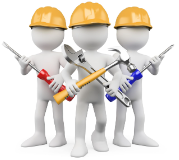Creating a Maintenance plan
 What does a maintenance plan mean
What does a maintenance plan mean
A maintenance plan describes an organization’s approach to maintaining machinery, equipment, and other operational assets. Creating a Maintenance plan secures long-term success for the facility.
Creating a maintenance plan is crucial in improving the safety, reliability and productivity of equipment.
Components of a maintenance plan
- Comprehensive inventory of physical assets
- Risk assessment
- Manufacturer recommendations
- Detailed routine maintenance task descriptions
- Actionable maintenance schedule
- Complete lists of the resources required for task completion
- Delegation of responsibilities
- Safety standards including industry best practices, regulatory requirements, and compliance checklists
- Documentation requirements
Differences between a maintenance plan and a Maintenance Schedules
Maintenance plan
A comprehensive maintenance plan is a longer document that describes the general approach to maintaining machinery or assets. It outlines the maintenance program’s goals and objectives, which may include enhancing asset life, decreasing downtime, or increasing reliability. It also lists all of the funds and personnel needed to carry out the maintenance plan.
Maintenance Schedule
A maintenance schedule is a more detailed document that lists the tasks that need to be done, how often they should be done, and what resources are required to complete them.
Steps for creating and implementing a maintenance plan
Conduct a Thorough Asset Inventory
- Utilize RFID or barcode technology to streamline asset tracking and identification.
- Implement a centralized database to store detailed asset information, including make, model, serial number, warranty details, and location.
- Conduct regular asset audits to ensure accuracy and update records as needed.
Perform a Criticality Assessment
- Employ Failure Mode and Effects Analysis (FMEA) to identify potential failure modes and their criticality to the overall operation.
- Calculate Risk Priority Number (RPN) to prioritize assets based on the severity of potential failures, the likelihood of occurrence, and the ease of detection.
- Consider factors such as: asset cost, downtime impact, safety risks, and regulatory compliance requirements.
Define Key Performance Indicators (KPIs)
- Align KPIs with overall business objectives and strategic goals.
- Use SMART goals: Specific, Measurable, Achievable, Relevant, and Time-bound.
- Consider KPIs such as: Mean Time Between Failures (MTBF), Overall Equipment Effectiveness (OEE), Mean Time to Repair (MTTR), and cost per unit produced.
Identify Essential Maintenance Tasks
- Refer to OEM manuals and industry best practices for recommended maintenance schedules and task descriptions.
- Utilize condition-based monitoring techniques (e.g., vibration analysis, infrared thermography) to identify potential issues early and optimize maintenance intervals.
- Consider preventive, predictive, and corrective maintenance strategies to balance cost and reliability.
Establish Metrics for Task Scheduling
- Implement a computerized maintenance management system (CMMS) to track asset usage, operating hours, and environmental conditions.
- Use statistical analysis to determine optimal maintenance intervals based on historical data and predictive modeling.
- Consider risk-based scheduling to prioritize tasks based on the potential consequences of failure.
Allocate Resources for Maintenance Tasks
- Develop a detailed resource plan that includes personnel, equipment, materials, and budget allocations.
- Utilize cost-benefit analysis to evaluate the economic justification for various maintenance strategies.
- Consider outsourcing options for specialized maintenance tasks or to reduce labor costs.
Develop Standard Operating Procedures (SOPs)
- Create clear and concise SOPs for each maintenance task, including step-by-step instructions, safety guidelines, and quality control checks.
- Utilize digital tools (e.g., augmented reality, interactive manuals) to enhance SOP accessibility and understanding.
- Conduct regular reviews and updates to ensure SOPs remain relevant and effective.
Incorporate Compliance and Safety Standards
- Stay up to date with industry regulations and standards (e.g., ISO 9001, OSHA, EPA).
- Conduct regular safety audits to identify and address potential hazards.
- Implement safety training programs for maintenance personnel to ensure compliance with safety protocols.
Create a Maintenance Schedule
- Use a CMMS to generate a centralized maintenance schedule that integrates with production planning and inventory management systems.
- Consider factors such as: asset criticality, task complexity, resource availability, and regulatory requirements.
- Implement a system for tracking and reporting maintenance activities to ensure compliance and identify areas for improvement.
Leverage a Computerized Maintenance Management System (CMMS)
- Select a CMMS that is scalable, user-friendly, and integrates with other enterprise systems.
- Utilize CMMS features such as asset tracking, work order management, inventory control, and reporting.
- Continuously improve and optimize the CMMS implementation to enhance maintenance efficiency and effectiveness.
Automating your maintenance plan
Using a CMMS Software will go a long way to make maintenance easier and stress free
See Also: Essential Motor Maintenance Tips